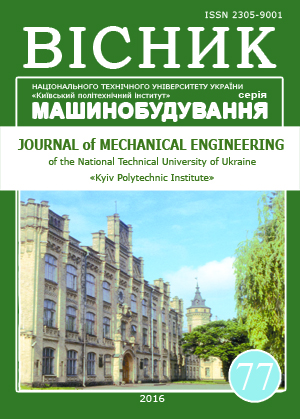THEORETICAL STUDY OF TEMPERATURE IN THE CONTACT ZONE cBN CUTTING TOOL
DOI:
https://doi.org/10.20535/2305-9001.2016.77.69897Keywords:
cutting tools, polycrystalline cubic boron nitride, coating, the temperature in the cutting zone, tool life, turningAbstract
The article is devoted to solving of actual scientific and technical task of increasing of tool life of the cutting tool equipped of cBN-Based PSHM while turning hardened steels. The concept of increasing of tool life of the PCBN cutting tools when turning hardened steel has been proposed, which is based on the reducing of temperature in the cutting zone. It was implemented by applying boron nitride coating with amorphous structure (BNam) on the working surfaces of the PCBN. Based on experimental data on the size of the contact area, contact loads and the topography of the contact areas of tools, the calculation of the value of temperature flashes was conducted. It was found that the change in temperature has an extreme character with a maximum of 2036 °C and 1044 °C on the sticking and sliding zones of contact area respectively. Wherein, it was revealed that a sufficient level of temperature for chemical interaction between instrumental and processed materials can be realized only in the sticking zone. The use of BNam coating reduces the temperature to 1770 °C in the sticking and to 893 °C in the sliding contact zones, hence reducing the intensity of reaction of the chemical interaction in the sticking zone of the contact area. On the basis of research and industrial tests of the obtained results it was found that exploitation of cBN tools coated with BNam allows one to increase the tool life of tool in comparison with the same tool without coating.References
Novikov, N.V. (2006), Superhard materials. Preparation and Use, Klimenko, S.A. (ed.), YSM im. V.N. Bakulya. Kyiv, Ukraine.
Klimenko, S.A., Kopeikina, M.Yu.and Melniychuk, Yu.A. (ed.), (2003), Iucrease in the efficiency of cutting tools with application of CBN-based polycrystalline superhard materials, J. of Superhard Mat. Vol. 25 no 5, pp. 69–73.
Turkevich, V.Z., Klimenko, S.A., Kulik, O.G. (1999), Thermodynamics of the interaction in the cBN-base tool material – Fe(Ni) system, Transactions saopstenja masinskog fakulteta. XXVIII, no 2, pp. 8–11.
Rizhkyn, A.A. (2005), The effect of temperature field parameters on tribological characteristics of friction pairs. Vestnik DHTU «Trenie i iznos», no 2, pp. 460–472.
Krahel'skyy, Y.V., Dobychin, M.N., Kombalov, V.S. (1977), Basics of calculations for friction and wear. Mashynostroenye, Moscow, Russia.
Müller-Hummel, P., Lathres, M. (1995), Temperature measurement on diamond-coated tools during machining. Ind. Diam. Rev. vol.55, no 2, pp. 78–83.
Klymenko, S.A., and Manohin, A.S. (2011), High-temperature phenomena in cutting materials, Nadiynist' instrumentu i optymizatsiya tekhnolohichnykh system, Zb. nauk. Pr, no 28, pp. 61-65, Kramators'k, Ukraine.

